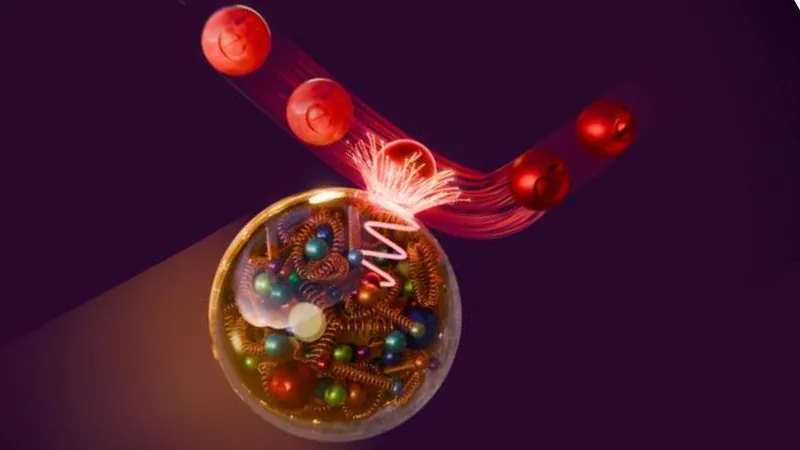
Scientists Unveil 'Spooky' Quantum Entanglement Within Protons—A Groundbreaking Discovery!
2025-01-07
Author: Yan
Introduction
In a remarkable stride for quantum physics, scientists have delved into the intricate structures of protons, the fundamental particles residing in the nuclei of all atoms, revealing that quarks and gluons—the building blocks of protons—exhibit quantum entanglement. This finding not only deepens our understanding of quantum mechanics but also challenges our longstanding perceptions of atomic structure.
Understanding Quantum Entanglement
Quantum entanglement, a phenomenon that allows two particles to influence each other's states instantaneously regardless of the distance separating them, has long intrigued physicists. Albert Einstein famously dubbed this mysterious occurrence "spukhafte Fernwirkung," or "spooky action at a distance," expressing his discomfort with the implications it held for the nature of reality itself. Despite his skepticism, numerous experiments have validated the existence of entanglement, showing that it can manifest over increasing distances. The recent study, however, takes a different path, focusing on the incredibly minute scale of one quadrillionth of a meter, illustrating that entanglement can occur within individual protons.
Research Methodology and Findings
The team of researchers, led by physicist Zhoudunming Tu from Brookhaven National Laboratory, spent six years investigating this mind-boggling phenomenon. They discovered that the entanglement occurs among groups of quarks and gluons contained within protons. "Our traditional view of the proton has revolved around the individual properties of quarks and gluons; now, with this evidence of entanglement, we realize that we're dealing with a much more complex and dynamic system," Tu explained. To probe this inner world, the researchers analyzed high-energy particle collisions, notably using data from the Large Hadron Collider (LHC) and the now-closed Hadron-Electron Ring Accelerator (HERA). When particles collide at astonishing speeds, debris dispersed from the collision provides insight into the entangled relations between quarks and gluons. The team utilized a technique developed in 2017 that harnesses the principles of quantum information science to gauge the level of disorder, or "entropy," present in the resulting particle sprays. Picture a chaotic child's bedroom—the more cluttered it is, the more "entangled" it is; conversely, an orderly room resembles a low-entropy state without such intricate connections.
Implications of the Findings
By cross-referencing their findings with complex entropy calculations against data from proton collisions at the LHC and the electron-proton collisions at HERA, the researchers found compelling evidence of maximal entanglement within protons. According to theorist Dmitri Kharzeev, "Entanglement exists not only between two particles but throughout all particles within the proton. The maximal entanglement we see arises from the strong interactions that create a multitude of quark-antiquark pairs and gluons." Understanding this entanglement paves the way for exciting new avenues in nuclear physics research. One critical question remains: how does the crowded environment of larger atomic nuclei impact the structure and behavior of protons? Does the presence of many interacting protons and neutrons lead to a phenomenon known as "quantum decoherence," disrupting entanglement?
Future Research Directions
To explore these tantalizing questions, the Brookhaven Lab's upcoming Electron-Ion Collider (EIC), set to commence operations in 2030, will be instrumental. By investigating entanglement in protons embedded within nuclei, scientists hope to illuminate essential connections between quantum mechanics and traditional nuclear physics phenomena.
Conclusion
As the world of quantum entanglement continues to unfold, this groundbreaking research not only deepens our understanding of the fundamental building blocks of matter but also promises to reveal the perplexing behaviors of particles at unprecedented scales. Stay tuned for more revelations in this mind-bending domain of science!




 Brasil (PT)
Brasil (PT)
 Canada (EN)
Canada (EN)
 Chile (ES)
Chile (ES)
 Česko (CS)
Česko (CS)
 대한민국 (KO)
대한민국 (KO)
 España (ES)
España (ES)
 France (FR)
France (FR)
 Hong Kong (EN)
Hong Kong (EN)
 Italia (IT)
Italia (IT)
 日本 (JA)
日本 (JA)
 Magyarország (HU)
Magyarország (HU)
 Norge (NO)
Norge (NO)
 Polska (PL)
Polska (PL)
 Schweiz (DE)
Schweiz (DE)
 Singapore (EN)
Singapore (EN)
 Sverige (SV)
Sverige (SV)
 Suomi (FI)
Suomi (FI)
 Türkiye (TR)
Türkiye (TR)
 الإمارات العربية المتحدة (AR)
الإمارات العربية المتحدة (AR)